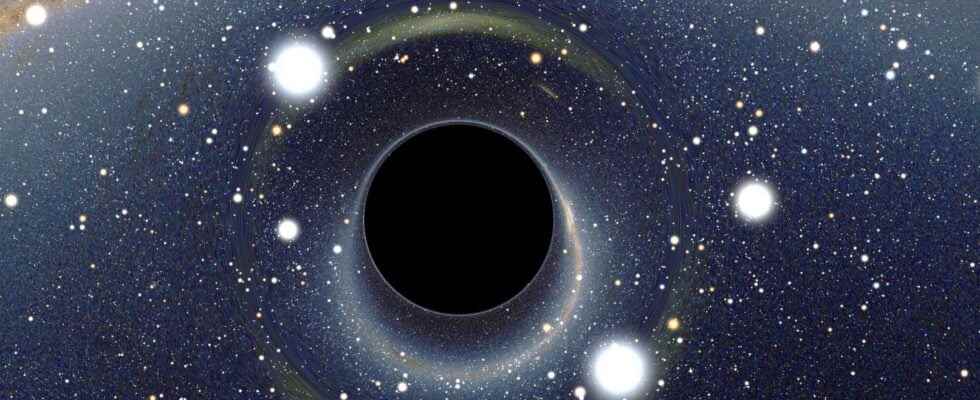For the first time, an isolated stellar black hole — that is, without a companion — has been detected. This invisible object revealed itself by producing a gravitational microlens.
You will also be interested
[EN VIDÉO] What would happen if you fell into a black hole? The depths of black holes are spaces of mystery and fantasy, but that doesn’t mean we can’t approach them scientifically. So let’s travel together to the frontiers of reality as we know it.
Between 10 million and 1 billion black holes hide in the Milky Way. However, detecting these objects is far from an easy task: they are invisible except when they trap matter. However, invisible does not mean undetectable. For the first time, an international team of scientists has succeeded in detecting a solitary and inactive black hole located at 5,200 ± 600 light-years. The article describing their discovery, submitted to The Astrophysical Journal and awaiting peer review, is already available in preprint on arXiv.
Lentil, black hole sauce
Even if we don’t see a black holeher gravity still exerts itself on its entourage. The light passing near is thus deflected, which changes the apparent position and (apparent) brightness of the source of that light. This phenomenon is called gravitational microlensing. Such microlenses make it possible to detect various objects, both stars dimly lit, exoplanetsfrom ” wandering planets “…Experiments set up to monitor the sky detect thousands of such events each year, most of them corresponding to stars moving in front of other stars.
The event detected on June 2, 2011 by the New Zealand-Japanese programs Microlensing Observations in Astrophysics (MOA) and Polish Optical Gravitational Lensing Experiment (Ogle), which peaked on July 20, is different, however: We report the first unambiguous detection and measurement of mass of an isolated stellar-mass black hole “, explain in their article Kailash Sahu, of the Space Telescope Science Institute, and his colleagues. ” We show that the lens emits no detectable light, which, in addition to having a mass greater than what is possible for a white dwarf or a neutron star, confirms its nature as a black hole “.
This event, designated MOA-2011-BLG-191/OGLE-2011-BLG-0462 (abbreviated MOA-11-191/OGLE-11-0462), is remarkable: not only was it unusually long, lasting about 270 days , but it also showed surprisingly high amplification. Since high-amplification events are sensitive to disturbances, such as those that might be produced by a planet orbiting the lensing object, scientists converged to take follow-up observations and perform analysis.
A black hole on the run
Observations from the region help space telescope Hubblespread over eight epochs spread over six years, allowed Sahu and his team to find that the best model for the data was a black hole of 7.1 ± 1.3 solar masses. Its event horizon would therefore have a diameter of only 42 kilometers. Scientists have thus detected an invisible object, half as wide as Corsica, at just over 5,000 light years.
In addition, the team was able to calculate the speed at which this object moves in the Milky Way: 45 kilometers per second. This makes it not just an old black hole, but a runaway black hole. He was probably ejected into space when its progenitor star exploded in supernova. If such a supernova explosion is asymmetric, the uneven force can hurl the star’s collapsed core into space. The white dwarf LP 40-365 and the pulsar PSR J0002+6216 are two other examples of objects in this case. According to a 2019 study, millions of black holes could be in this case in the Milky Way.
It is possible that the object is drifting through a high density region of space. According to the researchers, future work could involve the use of telescopes at X-raysto determine if the putative black hole is accreting matter of the surrounding interstellar medium. Future instruments could also detect other isolated stellar-mass black holes. Once an entire population has been discovered and studied, this data can be used to learn more about MOA-11-191/OGLE-11-0462 and the black holes that inhabit the Milky Way in general.
What you must remember
- In 2011, an unusually long microlensing event with unusually high amplification was detected.
- This event was produced by an isolated black hole about 7 solar masses 5,200 light-years away.
- Future research could detect many other analogous black holes that probably exist in the millions in the Milky Way alone.
Interested in what you just read?
